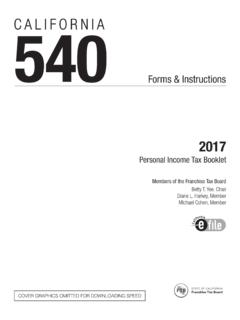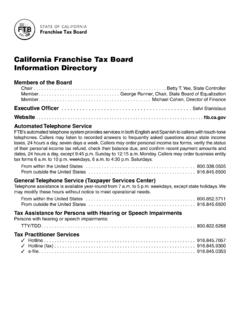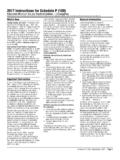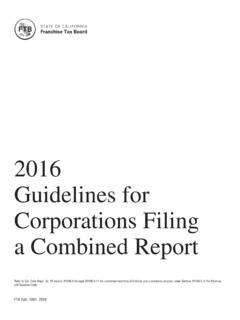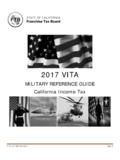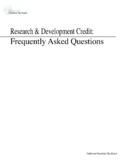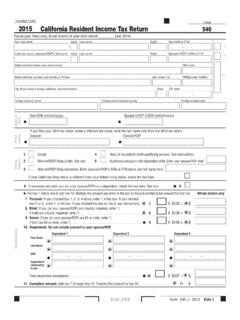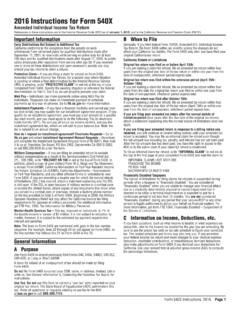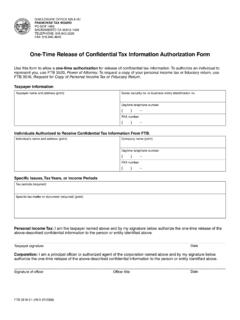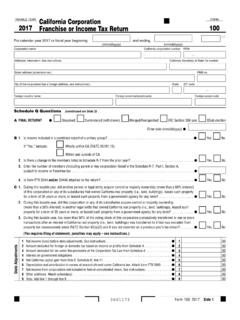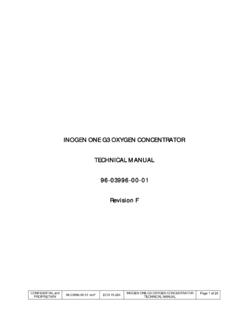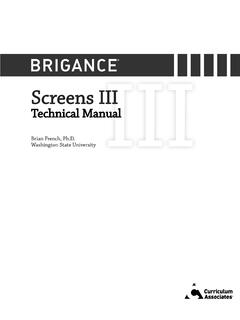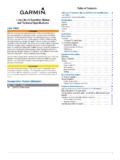Transcription of Residency and Sourcing Technical Manual - California
1 Residency and Sourcing Technical Manual (Rev. 11/2022) The information provided does not reflect changes in law, regulations, notices, decisions, or administrative procedures that may have been adopted since the Manual was last updated. Contents Residency and Sourcing Technical Manual .. 1 1000 OVERVIEW .. 4 1100 Introduction .. 4 1200 Audit Objectives and Audit Standards .. 4 2000 Residency LAWS, TERMS, AND Residency CONCEPTS .. 5 2100 Definition of Resident .. 5 2200 Temporary or Transitory Purpose .. 6 2300 Seasonal Visitors, Tourists, and Guests .. 8 2400 Presumption of 9 2500 Definitions of Domicile .. 9 2600 Domicile v Residency .. 11 2700 Definition of Nonresident .. 11 2800 Definition of Part-Year Resident .. 12 2900 Military Personnel .. 12 3000 SOURCE OF INCOME LAWS, TERMS, AND 13 3100 California Taxation .. 14 3150 Community 20 3160 Community Property Jurisdictions .. 20 3170 Community Property Definition.
2 20 3180 Separate Property .. 21 3190 Separation of Spouses .. 21 3195 How To Split Income Between Spouses, Then Source .. 21 3200 Compensation for Personal Services .. 22 3205 Taxpayer Becomes a California Resident (Move-In) .. 22 3210 Taxpayer Becomes a Nonresident (Move-Out)/Taxpayer is a Nonresident for the Entire Year .. 23 3215 Allocation of Compensation .. 24 3220 Sick Leave, Vacation Pay, Bonuses, and Severance Pay .. 26 3225 Deferred Compensation Plans .. 26 3230 Tax Equalization Payments .. 27 3235 Moving Expenses .. 27 3250 Equity-Based Compensation .. 27 3255 Introduction .. 27 3260 Internal Revenue Code Section 83 .. 29 3265 Nonstatutory Stock Options (NQSO) .. 29 3270 Incentive Stock Options .. 31 3275 Restricted Stock and Restricted Stock Units (RSU) .. 37 3280 Employee Stock Purchase Plans .. 39 3285 California Qualified Stock Options .. 41 3290 Summary Table .. 41 3300 Qualified Pension, Profit Sharing, and Stock Bonus Plans.
3 44 3350 Intangible Personal Property .. 45 3400 Business, Trade, or Profession .. 47 3450 Real or Tangible Personal 50 3500 Flow-through Income from Pass-Through Entities (PTEs) .. 50 3550 Trust Income .. 54 3600 Installment Sales .. 55 3650 Deferred Gains and Losses (like-kind exchanges) .. 57 3700 Tax Treaties with Foreign Countries .. 58 3750 Gains and Losses From the Sale or Trade of Business Property .. 58 3800 Capital Gains and Losses .. 59 3850 Individual Retirement Accounts (IRAs) .. 66 3900 Royalties and Residuals .. 66 3910 Convenant Not to Compete - Sale of Business .. 66 3920 Alimony .. 67 3930 Deductions .. 68 3940 Net Operating Losses .. 69 3950 Alternative Minimum Tax .. 77 3960 Passive Activity Losses .. 80 3970 Other State Tax Credit .. 87 3980 Professional Athletes .. 90 3985 Duty Day Allocations .. 91 3990 Playing vs. Signing Bonuses .. 91 3995 Endorsement Income .. 92 4000 Residency AND Sourcing AUDIT GUIDELINES.
4 92 4100 Tax Forms and Reference Publications .. 93 4200 Identifying Residency and Sourcing Cases .. 95 4300 Pre-Audit Analysis .. 95 4310 Scoping Returns .. 96 4320 Skip Tracing .. 97 4330 Reviewing Prior Audits .. 98 4340 Review Related Entities' Tax Returns .. 98 4350 Researching Tax and Case Law .. 98 4360 Evaluating Case Materiality .. 99 4400 Opening the Audit .. 99 4410 Overview of the Residency Audit Issue .. 99 4420 Setting Up Audit Workpapers .. 99 4430 Residency Audit Issue Section (AIS) .. 100 4440 Identifying What Preliminary Information is Needed .. 104 4450 Initial Contact Letter .. 105 4460 Audit Discussion .. 105 4500 The Ongoing Audit .. 105 4510 Gathering Relevant Information .. 106 4520 Responses to Information Document 106 4530 Third-Party Contacts .. 107 4540 Subpoenas .. 108 4550 Affidavits and Declarations .. 108 4555 Lead Review .. 108 4560 Financial Records .. 109 4570 Physical Presence.
5 111 4580 Documenting the Audit .. 111 4600 Making the Audit Determination .. 112 4610 Summary of Facts .. 112 4620 Determining Domicile .. 114 4630 Determining 115 4640 Position Letter .. 115 4650 Taxpayer's Position .. 116 4660 Rebuttal to Taxpayer's Position .. 116 4670 Rebuttal Letter .. 116 4680 Alternative Position .. 116 4700 Closing the Audit .. 117 4710 Narrative Report .. 117 4720 Case Review .. 117 4730 Case Assembly .. 117 1000 OVERVIEW RSTM 1100 Introduction RSTM 1200 Audit Objectives and Audit Standards 1100 Introduction We designed the Residency and Sourcing Technical Manual (RSTM) to assist you in conducting Residency and source of income audits. Franchise Tax Board Notice 94-8 explains that manuals provide you with guidance, but are not authoritative. Neither you nor the taxpayer can cite the Manual to support a tax position. This Manual is not a substitute for researching the laws and court or Office of Tax Appeals (OTA) decisions pertinent to an audit issue.
6 Unless otherwise specified, all section references relate to sections of the California Revenue and Taxation Code (R&TC) or the California Code of Regulations (CCR) Title 18, Division 3. Statements of law in the RSTM reflect the law on the Manual 's revision date. The Manual contains three major sections: RSTM 2000 Residency Laws, Terms, and Concepts RSTM 3000 Source of Income Laws, Terms, and Concepts RSTM 4000 Residency and Sourcing Audit Guidelines 1200 Audit Objectives and Audit Standards You conduct yourself and your work in a manner that is both fair and effective. You correctly apply and administer the tax laws in a reasonable, practical, fair, and impartial manner. You conduct your audits in a reasonable manner within the boundaries of the law, with sound administration, minimal delay, courtesy, and respect to taxpayers. To achieve your objective, you conduct your audits in a manner which is not unnecessarily burdensome, costly, or intrusive to taxpayers.
7 Our goal is to continually strive for quality, effectiveness, and economy in the services provided to taxpayers. During the audit process, you identify issues; obtain, evaluate, and document information; and arrive at the correct determination. Your decision is supported by a reasonable interpretation of the tax laws. You conduct your audits in adherence with the following audit standards in all cases: Legality Ensure audit activities and conclusions agree with established laws and legal interpretations. Objectivity - Examine all relevant, available facts fairly and without bias. Timeliness - Conduct and complete audits with minimum inconvenience to taxpayers. Supportability - Adequately support recommendations with facts and law. Refer to the Manual of Audit Procedures, MAP, for further information concerning audit procedures. 2000 Residency LAWS, TERMS, AND Residency CONCEPTS RSTM 2100 Definition of Resident RSTM 2200 Definition of Temporary or Transitory RSTM 2300 Seasonal Visitors, Tourists, and Guests RSTM 2400 Presumption of Residency RSTM 2500 Definition of Domicile RSTM 2600 Domicile v.
8 Residency RSTM 2700 Definition of Nonresident RSTM 2800 Definition of Part-Year Resident RSTM 2900 Military Personnel 2100 Definition of Resident R&TC Section 17014(a) defines "resident" as: Every individual who is in this state for other than a temporary or transitory purpose; and Every individual domiciled in this state who is outside the state for a temporary or transitory purpose. The statutory definition of "resident" contains two alternative tests, the satisfaction of either one leads to a conclusion that the individual is a resident of this If a taxpayer is inside California for other than a temporary or transitory purpose, regardless of place of domicile2, he or she is a resident of California . This is sometimes referred to as the inside or inbound Further, if a taxpayer is a domiciliary of California , he will be a California resident if his absences from California are for temporary or transitory purposes.
9 This is sometimes referred to as the outside or outbound The policy behind California 's personal income taxation of residents is to ensure that individuals, who are physically present in the state enjoying the benefits and protections of its laws and 1 Appeal of L. Mazer and M. Mazer, 2020-OTA-263P (July 23, 2020) 2 In most, if not all, Residency disputes a taxpayers physical presence is generally blended betw een two or more locations; as such, this prong generally refers to taxpayers domiciled outside of California who have a physical presence inside of Appeal of L. Mazer and M. Mazer, supra 4 Appeal of L. Mazer and M. Mazer,supra government, contribute to its support, regardless of the source of their 2200 Temporary or Transitory Purpose CCR Section 17014(b) provides a detailed discussion of the meaning of "temporary or transitory purpose.
10 " According to this regulation, the determination of whether or not an individual is in this state for temporary or transitory purposes depends to a large extent upon the facts and circumstances of each particular case. Generally, we consider an individual to be in California for a temporary or transitory purpose, and therefore a nonresident of California , if he or she is: Simply passing through this state. Here for a brief rest. Here for a vacation Here for a short period to complete a particular transaction, perform a particular contract, or perform a particular engagement. An individual will be considered to be in California for other than temporary or transitory purposes, and therefore a California resident, if he or she is in this state: To recuperate from injury or illness for a relatively long or indefinite period. For a business purpose which will require a long or indefinite period to accomplish.
